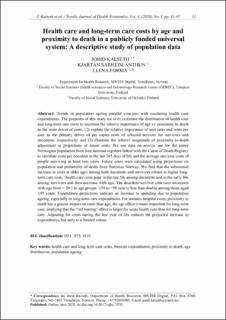| dc.contributor.author | Kalseth, Jorid | |
| dc.contributor.author | Anthun, Kjartan Sarheim | |
| dc.contributor.author | Forma, Leena | |
| dc.date.accessioned | 2023-03-28T12:09:27Z | |
| dc.date.available | 2023-03-28T12:09:27Z | |
| dc.date.created | 2020-12-16T09:57:18Z | |
| dc.date.issued | 2020 | |
| dc.identifier.citation | Nordic Journal of Health Economics. 2020, 8 (1), 31-45. | en_US |
| dc.identifier.issn | 1892-9729 | |
| dc.identifier.uri | https://hdl.handle.net/11250/3060721 | |
| dc.description.abstract | Trends in population ageing parallel concerns with escalating health care expenditures. The purposes of this study are to (1) estimate the distribution of health care and long-term care costs to ascertain the relative importance of age vs. proximity to death as the main driver of costs; (2) explore the relative importance of user rates and costs per user as the primary driver of per capita costs of selected services for survivors and decedents, respectively; and (3) provide projections of future costs. We use data on service use for the entire Norwegian population from four national registers linked with the Cause of Death Registry to calculate costs per decedent in the last 365 days of life and the average one-year costs of people surviving at least two years. Future costs were calculated using projections on population and probability of death from Statistics Norway. We find that the substantial increase in costs at older ages among both decedents and survivors relates to higher long-term care costs. Health care costs peak in the late 50s among decedents and in the early 80s among survivors and then decrease with age. While costs in the last year of life for each decedent are 19 times the average costs of survivors, the decedent/survivor cost ratio decreases with age to less than double among those aged ³95 years. Expenditure projections indicate an increase in spending due to population ageing, especially in long-term care expenditures. For somatic hospital costs, proximity to death has a greater impact on costs than age; the age effect is more important for long-term care, implying that the “red herring” effect is larger for acute health care than for long-term care. Adjusting for costs during the last year of life reduces the projected increase in expenditures, but only to a limited extent. | en_US |
| dc.language.iso | eng | en_US |
| dc.publisher | Universitetet i Oslo | en_US |
| dc.rights | Navngivelse 4.0 Internasjonal | * |
| dc.rights.uri | http://creativecommons.org/licenses/by/4.0/deed.no | * |
| dc.title | Health care and long-term care costs by age and proximity to death in a publicly funded universal system | en_US |
| dc.type | Peer reviewed | en_US |
| dc.type | Journal article | en_US |
| dc.description.version | publishedVersion | en_US |
| dc.rights.holder | © 2020 The Authors | en_US |
| dc.source.pagenumber | 31-45 | en_US |
| dc.source.volume | 8 | en_US |
| dc.source.journal | Nordic Journal of Health Economics | en_US |
| dc.source.issue | 1 | en_US |
| dc.identifier.doi | 10.5617/njhe.7070 | |
| dc.identifier.cristin | 1860365 | |
| dc.relation.project | Norges forskningsråd: 214298 | en_US |
| cristin.ispublished | true | |
| cristin.fulltext | original | |
| cristin.qualitycode | 1 | |

